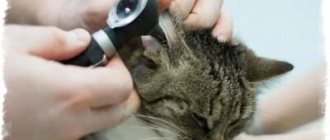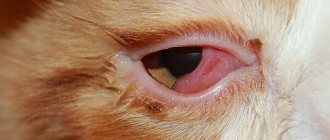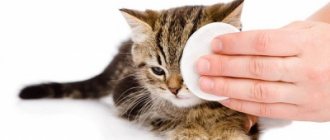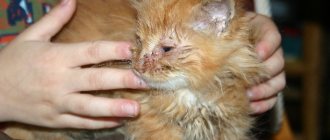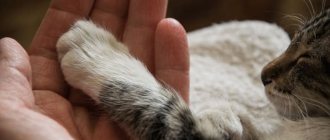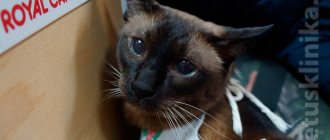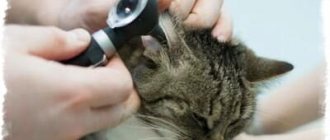The kitten's fragile immunity, restlessness and curiosity make the pet vulnerable to various infections and injuries.
Purulent discharge from the eyes is a common symptom not only of traumatic damage to the conjunctiva, but also of damage to the body by a viral, bacterial or other infection.
We will consider below what to do correctly when purulent discharge is detected.
Causes
Six main reasons for the formation of purulent discharge from the eyes of a kitten:
- allergic reaction to food, dust, pollen, medications, household chemicals, indoor plants, etc.;
- eye injuries;
- kitten diseases of a viral or bacterial nature, or helminthic disease;
- specks, foreign bodies in the eye (earth, sand, etc.);
- hypothermia of the kitten, for example, if the pet’s sleeping area is exposed to drafts;
- heredity, the breed's tendency to eye diseases.
About diseases
Infectious pathologies of various types interfere with the normal functioning of furry friends. When infected, the cat begins to sneeze, develops snot and even purulent discharge in the eye area.
© shutterstock
The list of abnormalities that cause a cat to get sick and sneeze may be different, for example:
- conjunctivitis;
- metabolic disease;
- external factors, for example, backcombing until it bleeds;
- injuries;
- inflammatory processes;
- and others.
You can't do this without a veterinarian. The pet sneezes, begins to worry, become nervous, the eyes become watery, and mucus starts to flow from the nose. There's definitely no time for joy here. But you cannot decide on your own how to treat a cat. You need to get to the root of the problem.
Species susceptibility
The breeds that are most often susceptible to purulent inflammation of the conjunctiva include:
- Scottish - due to the anatomical features of the muzzle (the lacrimal gland duct is shortened), frequent lacrimation causes the wool to get wet and become soaked, which creates a favorable environment for inflammation;
- British - facial features similar to the Scottish breed and a tendency to allergic reactions;
- Persian - a modified nasolacrimal duct due to the peculiar structure of the muzzle;
- Himalayan and Burmese - for them eye diseases are hereditary;
- Sphynx - low resistance to hypothermia and the absence of fur around the eyes, which performs a protective function.
Diagnostics in a veterinary clinic
The discharge of purulent exudate from a kitten’s eyes can be not only an eye disease, but also a signal of a dangerous infection in the pet’s body. A responsible owner's best bet is to visit a veterinarian immediately. The kitten’s immunity is very weak and without the provision of qualified medical assistance, the development of infection can destroy the pet.
When diagnosing, the following is carried out:
- examining a sick kitten for the presence of foreign bodies or traumatic eye injuries;
- finding out the reasons that irritate the mucous membrane of the eye;
- the nature and frequency of purulent discharge;
- microanalysis of washout from the mucous membrane of the eye;
- urine and stool analysis.
Depending on the condition of the animal and the nature of the illness, the doctor may prescribe:
- Ultrasound of the affected eye;
- X-ray of the skull;
- examination with an ophthalmoscope.
Medicines: eye drops and ointments
Antibiotic eye drops are prescribed, usually with a broad spectrum of action (albucid, tsipromed, floxal, tobrex, chloramphenicol, and many others). In case of heavy purulent discharge, numerous antibiotic eye ointments exist and are successfully used: tetracycline, erythromycin, gentamicin, framycetin, etc. There is usually no need for oral antibiotics.
Special cases that require a strictly differentiated individual approach include conjunctivitis in pregnant women, newborns, people with weakened immune systems and severe somatic patients, as well as conjunctivitis with reasonable suspicion of the presence of a specific infectious agent. Such cases are not considered here.
In conclusion, it should be repeated again and again: any treatment, and especially antibiotic therapy, should be prescribed, monitored, and canceled only and exclusively by a doctor.
Treatment method and prognosis
The success of treatment depends on timely consultation with a doctor and a correct diagnosis.
In case of injury, depending on the damage, medications for pain syndrome, antibacterial, anti-inflammatory eye drops (ointments) may be prescribed, and in complicated cases (based on diagnostic results), antibiotics may be prescribed.
In case of blepharitis (inflammation of the eyelids), the doctor finds out the cause of the disease and prescribes the necessary treatment. In a kitten, the appearance of blepharitis may be associated with a lack of vitamins and poor diet.
If conjunctivitis is confirmed, the doctor prescribes comprehensive treatment. If you do not help your pet, the disease will eventually spread to the second eye and then to the nasopharynx.
In case of keratitis (inflammation of the cornea), the doctor determines the cause of suppuration of the organ of vision and prescribes a course of treatment.
In case of infectious lesions in the kitten’s body, the doctor prescribes general antibiotic therapy.
To preserve not only the vision, but also the life of the pet, it is very important to take the animal to the doctor when any pathology is detected: early diagnosis and effective therapy increase the chances of a favorable outcome of the treatment process.
How to put drops in a kitten's eyes
A small pet must be handled carefully, and before washing the kitten’s festering eyes, you need to figure out how to hold the animal so as not to injure or frighten it.
Place your baby on his back with his face pointing up. If the kitten's eyes do not open, soak the eyelids with chamomile infusion or boiled water. After this, remove the pus and only then instill the medicine.
On average, therapy lasts about a week, but much depends on the degree of neglect of the disease and its nature.
Remember, self-medication should be used only in one-time cases of purulent discharge. If ichor is constantly secreted, abundantly, and there are other symptoms of a dangerous pathology, use the services of a specialist. As an example, with conjunctivitis, a kitten should be examined for chlamydia. Another examination is needed to find out how tolerant the pet is to antibiotics.
Among other things, the veterinarian knows exactly what treatment to prescribe in each individual case, which greatly increases the chances of successfully resolving the situation and, as a result, the kitten maintains full vision and health.
What to do at home
At home, it is necessary to strictly follow all doctor’s prescriptions, and ensure that medications are stored in accordance with the recommendations of the medical instructions.
To create conditions conducive to recovery, you need to provide your pet with a warm sleeping place in a quiet corner without drafts.
Nutrition is of great importance: the diet should be supplemented with vitamin supplements and ensure it is balanced.
Before carrying out the procedures, it is important for the owner to thoroughly wash their hands with soap and use separate wipes to clean each kitten’s eye of dirt. When used in the treatment or purification of solutions, the temperature of the liquids should not be lower than 37 degrees.
In the room where the kitten is located during treatment, the following are required:
- daily wet cleaning;
- replacing bedding on the animal's sleeping area;
- body temperature control;
- eye condition monitoring.
Treatment of purulent conjunctivitis
It is known that in most cases, a bacterial infection of the conjunctiva can be suppressed by the body’s own defenses: even in the absence of treatment, the immune system copes in 5-14 days. Therefore, bacterial cultures, as a rule, are not prescribed (except in cases where there is reason to suspect chlamydial, tuberculosis, gonococcal and other specific infections).
Symptomatic treatment usually includes vasoconstrictor and antiseptic rinses (eg, solutions of furatsilin, boric acid, etc.); in case of intense pain, drops with an anesthetic (eg lidocaine) can be prescribed. Rinsing with decoctions of chamomile, sage, tea and other plants with aseptic properties is possible, but it should be clearly understood: this is not therapy, but only the elimination of uncomfortable symptoms. Etiopathogenetic treatment aimed at eliminating the bacterial source of the inflammatory process involves the use of antibiotics. Here it is critical to follow the ophthalmologist's instructions literally and verbatim, i.e. take treatment exactly as much and in such doses as prescribed by the doctor (first of all, do not cancel it without permission), so as not to increase the risk of relapse and not to make your own “contribution” to the formation of drug-resistant bacterial strains, which is a serious national problem.
Possible complications
If you refuse to visit the clinic and choose medications for your pet on your own, the disease takes on an advanced form and is dangerous due to its relapses. Fungal and parasitic skin lesions (mainly on the head) are possible, worsening the pet’s condition.
With an advanced form of infectious diseases and a kitten’s weak immunity, the pet will not be able to survive.
With eye disease and unqualified assistance, the damage affects the deep layers of the eye. In this case, the pet faces loss of vision.
Symptoms (signs)
Bacterial conjunctivitis has a number of distinctive features in comparison with other infectious conjunctivitis. In particular, a viral infection is transmitted by airborne droplets, while a bacterial infection is transmitted by contact, incl. through unwashed hands, contaminated towels, pillowcases, etc. Hence the age-related differences in epidemiological data: in adults the ratio of viral to bacterial conjunctivitis is 5.6:1, while in children these frequencies are approximately the same. In general, the incidence of infectious conjunctivitis in childhood is much higher, which is explained by the very high contagiousness of the main pathogens, the characteristics of children's groups, the infantilism of the immune system, and the lack of automated hygiene skills. Most often, bacterial conjunctivitis acquires the proportions of local epidemic outbreaks, so it is advisable to immediately exempt a sick child from visiting a child care facility.
There is also a real danger of infection of the newborn during passage through the birth canal if the mother’s urogenital infection is not treated in a timely manner.
Bacterial conjunctivitis is usually characterized by a violent, acute onset in one eye with possible involvement of the other. Typical signs are conjunctival hyperemia (redness, excessive blood filling of the vascular network), swelling, lacrimation, complaints of “sandy pain” and/or burning. The main symptom is mucopurulent exudate, which accumulates in especially large quantities during sleep and forms crusts (“sour eyes”), therefore, bacterial conjunctivitis is sometimes called “ purulent ”, and therefore the application of any bandages to the affected eye is contraindicated. In rare and most serious cases, ulcerative lesions of the cornea, retinitis, blepharitis, keratitis and their combinations may develop.
